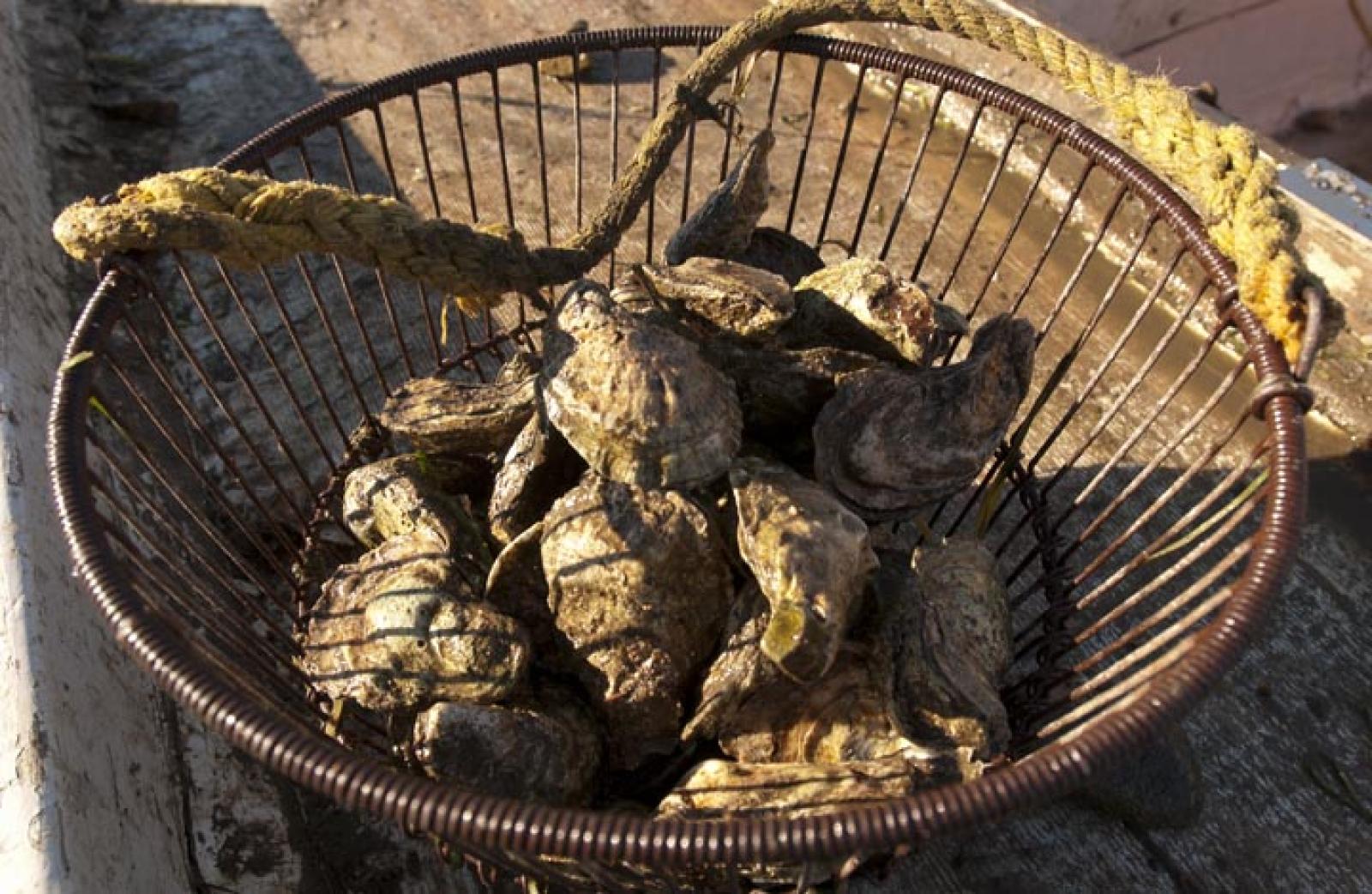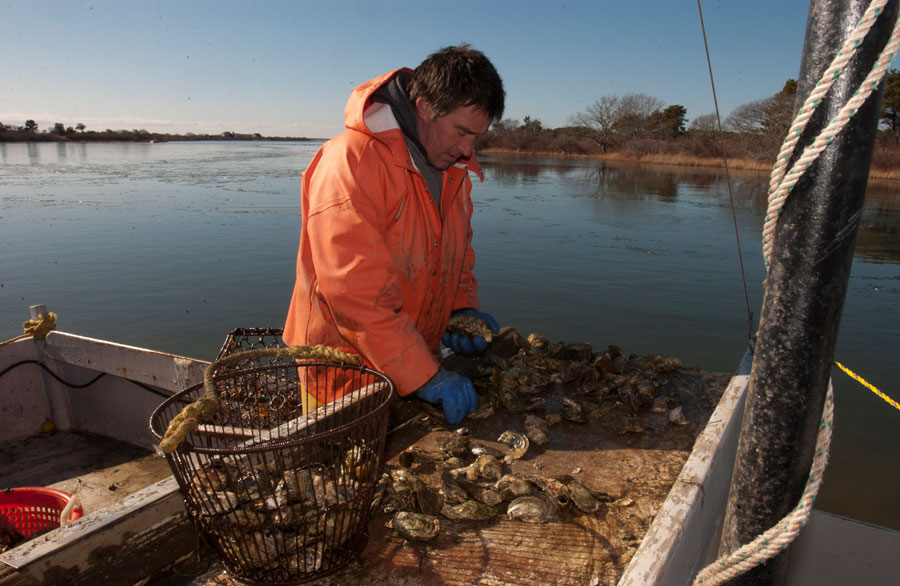Chez Panisse is arguably the best and most influential restaurant in the country. The restaurant’s founder, Alice Waters, has become the figurehead of the current farm-to-table revolution in America that has spread rapidly, including (thankfully) to Martha’s Vineyard. The chefs at Chez Panisse have to work their way up through a rigorous kitchen hierarchy, putting in countless hours peeling carrots and cardoons just for the opportunity to cook for those paying customers who have traveled from places near and far to sample their ingenuity. The first item on the menu is always oysters: Hog Island oysters (from nearby Point Reyes Peninsula) served with mignonette sauce. With all the pride and precision that goes into the cuisine at Chez Panisse, the first option on their menu is always the unadulterated oyster. The choice is both confident and educated. They are offering an arguably perfect food, naked and basically as it exists in nature, with a suggestion of a sauce to accompany it.
Oysters are possibly nature’s best invention. They clean our surrounding waters with constant and thorough filtration, and as a food choice, they are rich in nutrients and minerals and high in protein, with a pure flavor of salt and life not found in any other form. When shucked immediately before consumption, oysters are literally alive while they slide down the back of your throat. Rebecca Stott in her book Oyster sums it up perfectly for me: “The oyster, raw food of both epicure and savage . . . sits on that border between culture and nature and between male and female, between land and sea, between cooked and raw.”
I have had the privilege of eating all over the world at some of the most prolific and exciting restaurants, with many of my most memorable evenings spent eating oysters. I used to work in Manhattan and would walk home late at night through Washington Square Park heading south into Soho. My apartment was two blocks from Balthazar, a place I would frequently and memorably slip into on my way to a sleeping dog and girlfriend. Sinking into a red booth, downing oysters and watching the choreographed mayhem of one of the city’s busiest restaurants made me feel and understand what was special about New York.
As a farmer and chef, I think about food all day long; literally it is all I think about. I cannot name another item from nature’s pantry that is enjoyed in its purest form more often than the oyster. And Vineyard oysters are on a par with any available anywhere.
Food and meals are influenced by the context in which they are consumed. Slurping oysters in Paris at Le Dôme with a tower of seafood in front of you makes you feel like a king. (Or maybe it is the champagne?) Eating them on the dock in Menemsha as the sun sets over the ocean in the autumn, when the crowds have gone and your sweater still smells musty from storage, makes you feel calm and blessed.
Oysters hold a special place in the hearts and memories of Islanders, including mine. I remember my dad boasting that my brother and I consumed them in mass quantities when we were still in diapers. I think of men like Danny Bryant, Nelson Bryant, Johnny Hoy or any member of the Larsen family making these joys possible for those less able to gather them on their own.
Martha’s Vineyard has changed a lot in my lifetime. I live in Chilmark, a place that offers a view of the world that begins with deep, humble agrarian roots and extends in all directions thanks to the seasonal residents who bring their unique experiences from every corner of the globe. Whether farmed or wild, from Menemsha or Katama, the oysters of Martha’s Vineyard offer us a taste of the pure, almost unblemished waters that surround our Island. No other food can offer us a chance to be connected to our surrounding waters like an oyster, or to be connected to a simple food that our Island inhabitants have enjoyed in the same way for centuries.
The Vineyard community is not a restaurant-centric one; maybe this will change in the coming years, but this focus on meals cooked at home and eaten with family and friends makes us all appreciate simplicity even more. We all know someone here on the Island who has access to oysters. My friend Shirley Mayhew, whose husband John worked on the first oyster farm on the Island in the 1940s on Quansoo Pond before starting his own in the same waters, told me there was no market for their oysters on the Island back then and nearly all of them were shipped to Boston. The Mayhews would drive down the street in their pickup truck with oysters overflowing out of the bed; Shirley told me everyone thought they were rich, but in truth they were getting pennies for their haul and soon the farm folded and they both became teachers. They ate oysters because they were growing them and could not afford anything else.
Today the oyster is a mainstay on menus created by the best chefs. Thomas Keller serves them first on the extensive tasting menus at the French Laundry in Napa Valley, and at Per Se, in Manhattan, choosing Island Creek Oysters from Duxbury. David Chang is serving them in multiple establishments he owns in New York and Sydney, Australia. Sean Brock, the acclaimed new southern chef working in Charleston, S.C., serves his local favorites nightly at his flagship Husk. I see new restaurants popping up all the time, making a splash in the food world with simple menus more often than not featuring oysters. They are a symbol of decadence, held in the same esteem as truffles, foie gras or caviar, yet cost a fraction of the price, making them accessible to a much broader audience.
Before Mr. Brock came onto the scene, Emeril Lagasse, one of the original food celebrities in our country, was responsible for putting southern food on the haute cuisine map. Louisiana is his adopted home; he is originally from Fall River. I had the privilege of cooking for him about eight years ago. It was a young chef’s greatest challenge: cooking a memorable meal for a chef of great importance who has most likely seen it all. My father had recently sent me a cardboard box filled with oysters from Menemsha Pond. I shucked them, served them over ice with mignonette sauce and lemons. I visited the table later on after copious amounts of wine had been served and many plates of pasta, and Emeril made it clear to me that the best part of his meal were the oysters. They reminded him of his childhood and he was grateful.








Comments (6)
Comments
Comment policy »